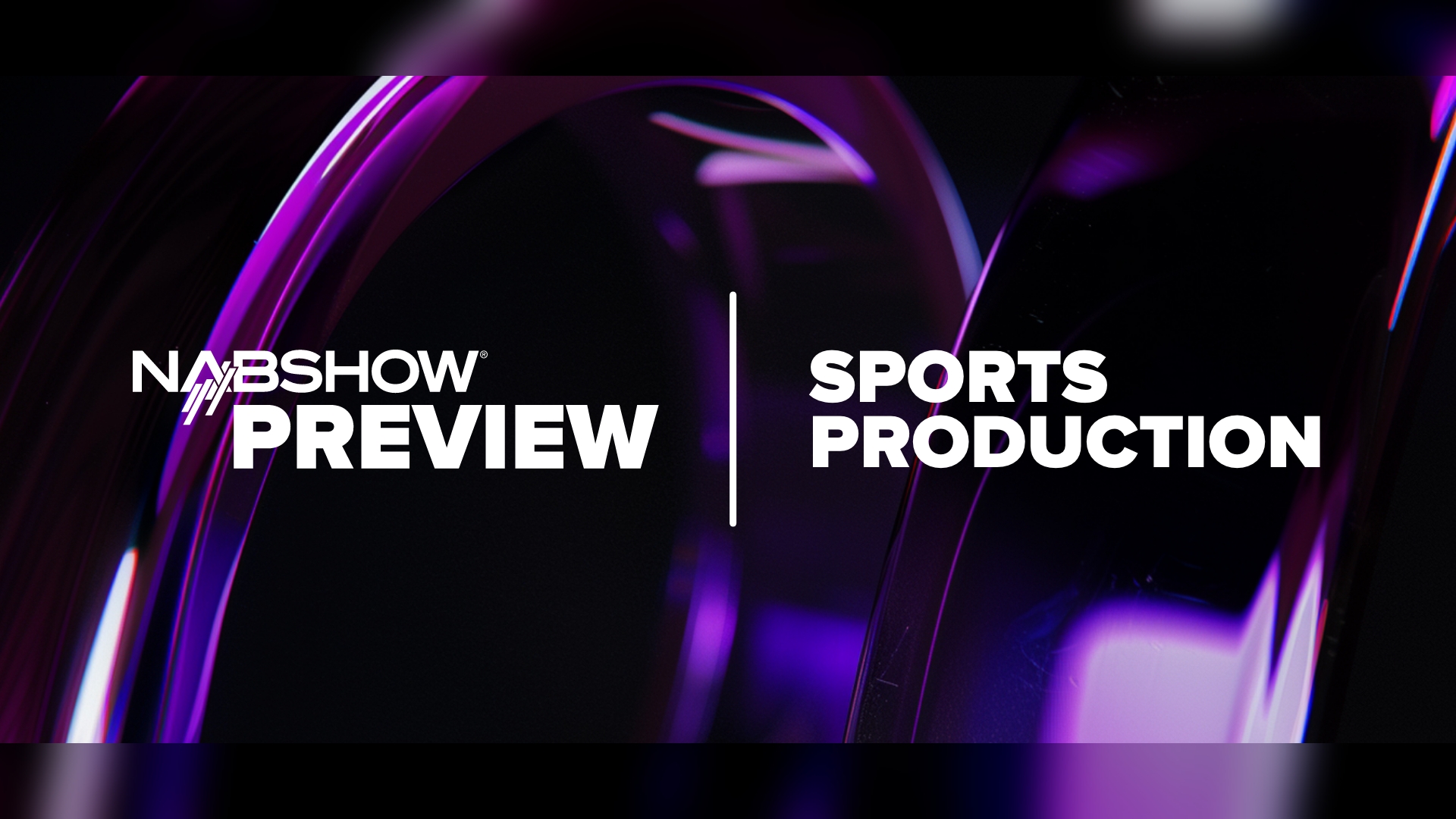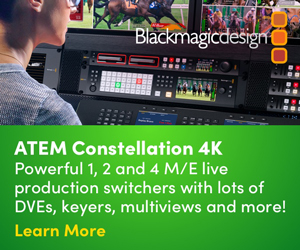NAB Show Preview: Sports production embraces IP, cloud and democratization

Subscribe to NewscastStudio for the latest news, project case studies and product announcements in broadcast technology, creative design and engineering delivered to your inbox.
From direct-to-consumer streaming to AI-assisted workflows, the sports broadcasting landscape continues evolving toward more flexible, efficient and accessible production models.
As sports broadcasters face unprecedented competition and expanding content demands, the upcoming NAB Show in Las Vegas will spotlight technologies aiming to modernize sports production workflows.
Direct-to-consumer revolution
The shift toward direct-to-consumer models represents one of the most significant transformations in sports broadcasting, with implications rippling throughout production workflows.
“The rapid shift toward direct-to-consumer streaming in sports broadcasting is fundamentally changing production requirements,” said Russell Johnson, co-founder and COO at Hitomi Broadcast.
“Sports organizations are increasingly developing their own streaming capabilities alongside traditional broadcast partnerships, driving demand for efficient quality control solutions that can handle multiple distribution channels simultaneously,” said Johnson.
This transition has accelerated as rights holders recognize the value of controlling their own distribution channels.
Traditional broadcasters now face competition not just from streaming platforms but increasingly from the sports organizations themselves.
“The shift towards sports organizers taking on the responsibility for distributing coverage of their own events, either on dedicated streaming platforms via websites or YouTube channels,” noted Erik Otto, CEO of Mediaproxy. “Many of these bodies have established in-house TV departments, headed by experienced professionals who previously worked for major broadcasters or freelanced at major competitions.”
This, in turn, also leads to more major league sporting events returning to local television through deals such as those with the Atlanta Braves and Gray Media.
Democratizing sports coverage
The democratization of sports production technology is bringing advanced production capabilities to organizations of all sizes – whether it’s a college game or a professional league.
“The democratization of real-time customization and media enrichment technology is hugely exciting for sports organizations and rights holders,” said Rick Young, SVP, global products at LTN. “Today, some of the most nimble, rapidly-growing sports leagues can harness the same level of advanced content versioning, language customization, graphics and multi-platform distribution tools that the biggest leagues use.”
This democratization extends beyond the major leagues, opening opportunities for previously underserved sports to build audiences.
“New media, bonded cellular, lower cost video switchers, 5G and IP-based systems and equipment, from the likes of NDI, Blackmagic Design and LiveU, have enabled organizing bodies, colleges and even schools to set-up their own broadcast facilities for streaming and YouTube coverage, offering the same quality as terrestrial channels and streamed services,” said Otto.
Remote production matures while cloud gains traction
Remote production continues to evolve as a cornerstone of sports broadcasting, enabling more efficient resource allocation and expanded coverage capabilities.
“Remote production has also revolutionized sports broadcasting, enabling more matches and events to be covered at lower cost,” Otto explained. “This trend seems set to continue through the use of AI-controlled cameras and AI-generated commentary, which means many sports that were previously overlooked by television can be in charge of their own destiny and attract a new generation of fans and viewers.”
The flexibility afforded by IP-based remote production workflows has proven particularly valuable as broadcasters seek to cover more events without proportional increases in production costs.
“Sports broadcasters and streaming platforms are under more pressure than ever to deliver high-quality, immersive live experiences while managing the complexity of increasing content demands,” said David Edwards, product manager at Net Insight. “The shift toward IP-based workflows, cloud scalability, and software-defined production models continues to drive conversations.”
Cloud-based production is increasingly integrated into workflows, providing scalability and flexibility previously unattainable with traditional infrastructure – and enabling automation.
“Broadcasters are looking for solutions that enable them to expand coverage across premium and lower-tier events without the constraints of traditional infrastructure,” Edwards said. “One of the core drivers of this shift is the growing need for efficient, scalable, and high-quality live content transport over unmanaged networks.”
The transition to cloud workflows has particular relevance for sports broadcasting, where production requirements can vary dramatically between events.
“We expect to see a lot of focus on cloud-native workflows that facilitate global content distribution without sacrificing quality or reliability,” Edwards noted. “Broadcasters are looking for ways to simplify their live media transport processes while maintaining the agility to scale up or down depending on the event.”
Automation gains momentum
As production teams manage increasingly complex workflows across multiple distribution channels, automation has become essential for maintaining quality while controlling costs.
“The industry’s growing recognition that automation and efficient quality control are essential for successful direct-to-consumer sports coverage,” Johnson said. “At Hitomi, we’re seeing increased interest in software-based deployments of our solutions as broadcasters prepare for distributed production models that can efficiently serve both traditional and streaming workflows.”
The evolution extends beyond simple process automation to sophisticated monitoring systems that help operators prioritize their attention.
“As broadcasters handle more channels with fewer personnel, especially in multi-language sports coverage, there’s growing demand for tools that can alert operators to potential issues rather than requiring constant manual monitoring,” Johnson explained. “This shift toward automated monitoring allows technical staff to focus their attention where it’s most needed, ensuring consistent quality across all distribution channels.”
The increasingly competitive landscape is pushing broadcasters to innovate across multiple dimensions simultaneously.
“Live sports continue to be a major driver of audience engagement, but the landscape is becoming more competitive,” said Simon Hawkings, director, sales strategy and business acceleration, Ross Video. “Streaming platforms like Amazon and Apple are aggressively securing sports rights, challenging traditional broadcasters to find new ways to differentiate themselves.”
The response involves embracing new technologies while focusing on creating distinctive viewing experiences.
“To stay ahead, broadcasters are investing in AI-assisted production for tasks like automated highlight generation, real-time data analytics, and enhanced fan engagement,” Hawkings added. “Remote production and cloud-based workflows are also playing a bigger role, helping networks reduce costs while maintaining high-quality coverage. The focus is now on delivering more immersive and interactive sports experiences to keep audiences engaged across multiple platforms.”
Cinematic sports aesthetics
The visual language of sports broadcasting continues to evolve, with viewers increasingly expecting cinematic production values even in live sports coverage.
“We’ve seen a concentrated shift in the creative direction of sports production, driven by viewers’ appetite for more cinematic moments during live broadcasts,” said Stosh Durbacz, vice president of sales, optical devices division, Fujifilm North America Corporation. “Fujifilm recognized this need and, with its long history and expertise in cinematic optics, felt there was an opportunity to innovate, ultimately creating a new category of lens to facilitate this growing demand.”
This aesthetic shift represents more than just a technical evolution — it reflects changing audience expectations shaped by experiences across multiple media platforms.
Financial pressures reshape priorities
Despite technological advances, traditional broadcasters face significant financial headwinds as they compete for premier sports rights against deep-pocketed streaming platforms.
“The biggest challenge in live sports production today, particularly for traditional broadcasters, is not technical but financial,” Otto noted. “Securing the TV rights to the big, high-profile events and leagues has been the top priority in broadcasting since the 1990s, when satellite and digital channels began to dominate sports coverage. These days they all have to compete with streaming platforms to cover the major competitions.”
This competitive landscape has pushed some broadcasters to explore alternative content strategies.
“The challenge for those broadcasters is to target sports that are either up-and-coming, such as women’s football, rugby and cricket, or less mainstream, including darts, snooker, bowls, curling and the luge,” Otto added.
With private equity increasingly investing in sports media ventures and technology companies racing to provide more accessible and powerful production tools, NAB Show 2025 will showcase an industry navigating rapid change while seeking sustainable business models.
“Private Equity groups are jumping in with both feet and are betting on new technologies to power multi-partner global rights deals and bring their live coverage to new digital platforms previously out of reach,” Young said. “Live sports are being delivered at a larger scale and with deeper content customization possibilities than ever before.”
As the exhibition approaches, it’s clear that sports production stands at the intersection of multiple industry trends all while facing intensifying competition for viewer attention.
Subscribe to NewscastStudio for the latest news, project case studies and product announcements in broadcast technology, creative design and engineering delivered to your inbox.






tags
Blackmagic Design, David Edwards, Erik Otto, Fujifilm, Hitomi Broadcast, LiveU, LTN, Mediaproxy, NAB Show 2025, NAB Show News, NDI, Net Insight, Rick Young, Ross Video, Russell Johnson, Simon Hawkings, Stosh Durbacz
categories
Heroes, NAB Show, Sports Broadcasting & Production